| The Zero Date Reconsidered |
|---|
| by Peter Meyer January 20, 2014 |
A distinction should be noted between the timewave as a mathematical object (a function which takes a non-negative real number and produces another non-negative real number) and the timewave as associated with historical time (which is seen in the graphs produced by the software illustrating the theory). The function is formally defined in The Mathematics of Timewave Zero.
Although not part of the mathematical definition of the timewave, Terence McKenna interpreted it in terms of 'novely' and 'habit', where descents of the timewave show an increase in novely (innovation, surprise) and ascents show a retreat into habit (routine, nothing new).
In the theory of Timewave Zero there is one and only one point where the value of the timewave is zero, and at all points prior to this the value is positive (and generally larger for points in time earlier than the point associated with the zero point). In order to make the points in the timewave correspond to points in historical time, some point in time must be chosen to correspond to the zero point. The date (assuming the timezone of GMT-5, the timezone of La Chorrera, Colombia) of the day during which this zero point occurs is called "the zero date". Terence McKenna claimed that there is reason to believe that the zero date was December 21, 2012 (and thus that the zero point was 6 a.m. La Chorrera time on this date). The basis for this claim was two-fold: (1) There is a reason to choose 2012-12-21 as the zero date rather than some oher date. (2) Using this zero date it can be shown (as he attempted to do in various public talks) that there are in fact correspondences between descents in the timewave and very novel periods in history.
Despite the common assumption to the contrary, the theory of Timewave Zero does not imply any particular date as the zero date, and in particular it does not imply that 2012-12-21 is the zero date. Any other date is theoretically possible.
In my article The Zero Date (written in 1999) I criticized the choice of December 21, 2012, as the zero date. Here is a restatement of that criticism:
The way in which the timewave is constructed from the King Wen Sequence of I Ching hexagrams implies that certain periods have particular significance, namely periods of one day (corresponding to one line in a hexagram), six days (since a hexagram has 6 lines), and 6*64 = 384 days (since the I Ching has 64 hexagrams). And therafter all periods of consisting of 384 multiplied by a power of 64, as in 384*64 = 24,576 days (about 67 years), 384*64*64 = 1,572,864 days (about 4,306 years), and so on. These periods could be called "cycles".
Terence McKenna assumed that any point on the timewave which preceded the zero point by a number of days in any of these periods, that is, any point which is the start or end of a cycle, must be a point of great novelty (compared to other points in the timewave); and thus that, when a correspondence between the timewave and historical time is made (by fixing the zero date), points in time corresponding to these points in the timewave will show great novelty. In particular, the point 24,576 days prior to the zero point would be a time of great novelty.
McKenna then assumed that, because of the observed increase of novely throughout human history, and in particular, from the early 20th Century up the the 1980s, that novelty was accelerating so much that the zero point could not be far off, and that it would be sometime early in the 21st Century. He thus looked for an event in the mid-20th C. which was so extremely novel that it could be associated with the cycle which began 24,576 days prior to the zero point. From the date of this event the zero date could be estimated by adding 24,576 days.
The event which seemed to McKenna the most novel event of the mid-20th C. was the use of an atomic bomb to incinerate Hiroshima, which occurred on August 6, 1945. Adding 24,576 days to this gives the date November 18, 2012. Influenced by the fact that the then-current 13-baktun cycle of the Maya Calendar ended in December 2012 (according to the most commonly accepted value for the correlation number, by which the Maya long count is connected to the Western calendars) McKenna adopted 2012-12-22 as the zero date, and around 1991 settled on 2012-12-21.
This reasoning made four assumptions:
- The beginning and end of any cycle corresponds to a time of great novelty.
- The zero date is likely a date in the early 21st C.
- The atomic bombing of Hiroshima is the event of greatest novelty in the mid-20th C.
- Despite the zero date that this reasoning leads to, the "end date" of the Maya Calendar is a more likely zero date for the timewave.
| All images of the timewave shown in this article were made using the DOS/Windows Fractal Time software (running via DOSbox), available on the CD-ROM and USB flash drive. |
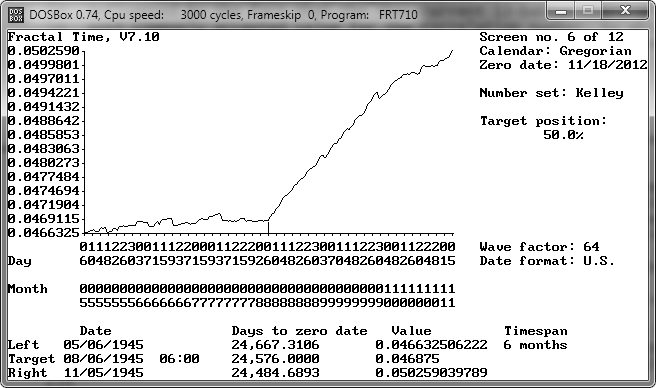
Note that the timewave preceding the date 24,576 days prior to the zero date (for any zero date) is a period which (over the course of three months) does not show any major ascent or descent. The choice of 2012-12-21 as the zero date has the effect of moving the timewave 33 days to the right, and thus of moving 1945-08-06 (the date of the Hiroshima bombing) into this period:
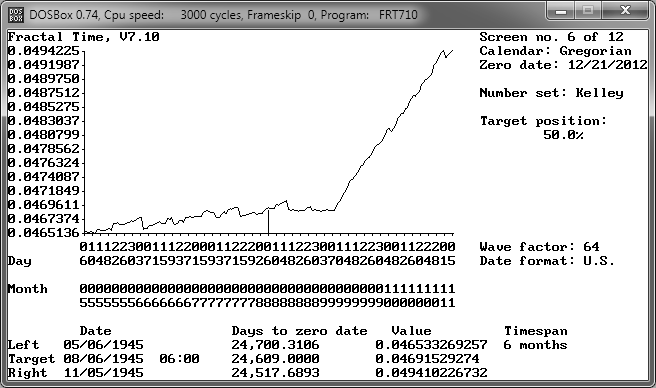
Thus the choice of 2012-12-21 as the zero date puts the date of the Hiroshima bombing into a period which does not show any major novelty, contrary to what is implied by a combination of assumptions #1 and #3.
Having shown that the reasoning used by Terence McKenna to arrive at a zero date of 2012-12-21 might all along have been seen as less than convincing, one can now ask if there is any reason to support a more plausible choice of a zero date. The answer is that, yes, there are several possibilities for a revised zero date.
Alternative 1
The Kelley timewave shows a major descent of the timewave beginning, not 24,576 days prior to the zero date but rather 16,384 days prior. (Note that 16,384 = 2^14.) This is true for any choice of zero date, for example, a zero date of 2018-08-26: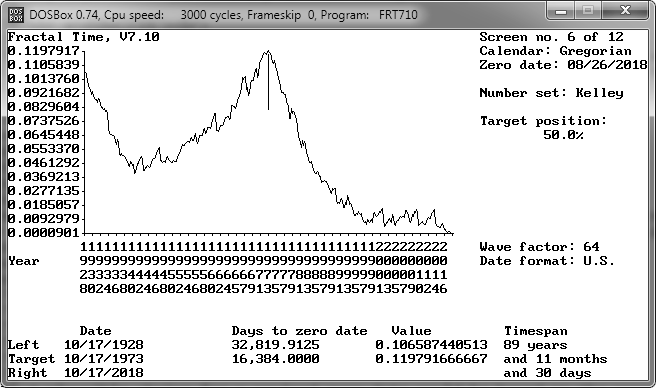
So we could look for an extremely novel event sometime during 1969-1979 and then add 16,384 days to that date to get a zero date sometime in 2014-2024. In fact the date of 1973-10-17 (the target date in the graph above) is such a date, because on that date:
Arab members of the Organization of Petroleum Exporting Countries (OPEC), in the midst of the Yom Kippur War, announced that they would no longer ship petroleum to nations that had supported Israel in its conflict with Egypt — that is, to the United States and its allies in Western Europe.And this "oil shock" had major economic repercussions. Adding 16,384 days to 1973-10-17 gives a zero date of 2018-08-26.
However, there are other candidates around this time for an extremely novel event, for example, Nixon's decoupling of the U.S. dollar from gold, which occurred on 1971-08-15 (this would give a zero date of 2016-06-23).
Alternative 2
When we examine the mathematics of the timewave we find (surprisingly) that any two dates which are major (a.k.a. geometric) resonances of each other imply a particular zero date.In Section 3 of The Mathematics of Timewave Zero it is shown that for any point on the timewave which is x days prior to the zero date, for which the value of the timewave is v, the value of the timewave at the point 64*x days prior to the zero date is 64*v. Since this is true also of the points in the vicinity of x, the shape of the timewave at the second point is the same as the shape at the first point. The ups and downs of the timewave represent novelty/habit, so the novelty/habit of the two points (and adjacent regions) is the same (just at a different scale). Two such points or regions of the graph are said to be in resonance, and they are major (a.k.a. geometric) resonances of each other, or more exactly first major resonances. (If related via 64*64 instead of simply 64 then they are second major resonances or each other.)
Suppose the units of time on the horizontal axis of the graph are days, and that each day is numbered according to the system of Julian day numbers (JDN), and suppose that the JDN of the zero point is z. Suppose that two events are located on the graph at JDNs d1 and d2 (with d1 < d2). Then the first event is z-d1 days prior to the zero date and the second is z-d2 days prior. Suppose they are first major resonances of each other, then (z-d1) = 64*(z-d2). This implies that z = ((64*d2)-d1)/63. Thus if we can find two events which are first major resonances of each other, then the JDNs of those events will give us a zero date.
As noted above, according to the Timewave Zero theory, events (and regions of the graph) that are major resonances of each other are such that the novelty (or habit) of one is exactly the same as the novelty (or habit of the other), but just at a different scale; and what occurs in time at one point is a reflection of, or analogous to, what occurs at the other. In his talks on the timewave Terence McKenna gave numerous examples historical events or periods in major resonance. See The Battle of Hastings (which occurred in 1066) for a detailed discussion of two events in 2008 which are candidates for being seen as the first major lower resonances of that event.
So (without assuming any particular zero date, since that is what we are trying to determine) we need to find two events that are so alike, or analogous, that they are very likely to be first major resonances of each other. Candidates for this are the assassination of John F. Kennedy (November 22, 1963, in the Gregorian Calendar) and the assassination of Julius Caesar (March 15, 44 BC, in the Julian Calendar), since both of these were politically motivated, were very surprising and had very significant consequences. The JDNs of these two events are d1 = 1,705,426 and d2 = 2,438,356. From the formula above for z we obtain (ignoring the fractional component) z = 2,449,989, which corresponds to September 28, 1995.
Since our revised zero date must be a date in the future (relative to 2012), this will not do, so we must reluctantly conclude that these two assassinations were not in fact first major resonances of each other. The problem remains, then, to find two events which are, and whose dates (JDNs) imply a zero date which is in the future.
Alternative 3
A plausible choice for a revised zero date could be based on the assumptions:- The peak at the start of a major descent of the timewave corresponds to an event of great novely (whose effects play out in the period following).
- The zero date is likely a date in the early 21st C.
- The attack on the World Trade Center and the Pentagon on 2001-09-11 is the event of greatest novelty in living memory.
9/11 was far more than a crime of mass murder. Firstly the evidence strongly suggests that the actual demolition of the Twin Towers was accomplished by the use of atomic bombs — only the second use in history of A-bombs against a civilian population, and this time by covert elements of the U.S. government against their fellow citizens (very likely actively assisted by covert elements of another rogue state), an event about as 'novel' as you could imagine.
Secondly the 9/11 attack was an act of terrorism perpetrated by the imperialist U.S. power elite in order to induce "shock and awe" among the U.S. population and con them into allowing (if not accepting) draconian changes in the relation between the U.S. government and its citizens, changes which amounted to (a) a complete abrogation of all civil rights supposedly guaranteed by the U.S. Constitution (thus opening the way to the overt emergence of a crypto-fascist militarized police state) and (b) carte blanche for the U.S. to engage in aggressive military action (or the threat of the same) against any country which it regards as a danger to its goal of total domination of the planet.
There was never anything of this magnitude before (though Pearl Harbor was an inspiration to those who planned 9/11). September 11th was an event novel enough to justify re-calibrating the timewave so as to give primary importance to 2001-09-11 as the most novel event, if not in all of history, at least the most novel in the last 20 years. And how might we do that? Simply by finding a zero date according to which September 11, 2011, is the peak of a huge descent in the timewave.
When we look at the final 20 years of the timewave (without regard for any particular zero date) we find this:
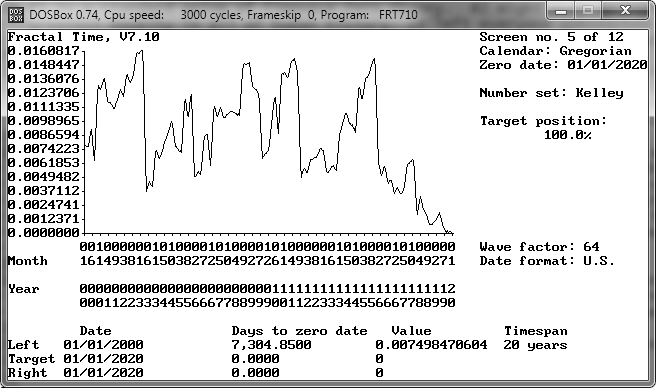
The three points on the timewave which are the initial points of the three deepest descents of the timewave occur 1,536 days prior to the zero date, 3,136 days prior and 6,144 days prior. When we add these numbers of days to September 11, 2001, we obtain: 2005-11-25, 2010-04-13 and 2018-07-08 respectively. Since our revised zero date must be in the future, that leaves just one candidate: July 8, 2018. With this zero date the timewave at September 11th looks like this:
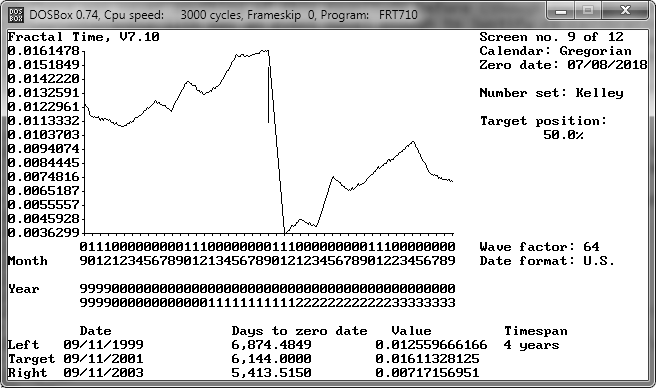
Thus if assumptions #1 - #3 are held to be plausible then July 8, 2018, is a plausible candidate for a revised zero date, and (due to objections which could be raised to the other candidates mentioned in this article) it is the most plausible.
It remains to be shown that using this revised zero date there are correspondences between other major descents in the timewave and very novel events and periods in history.
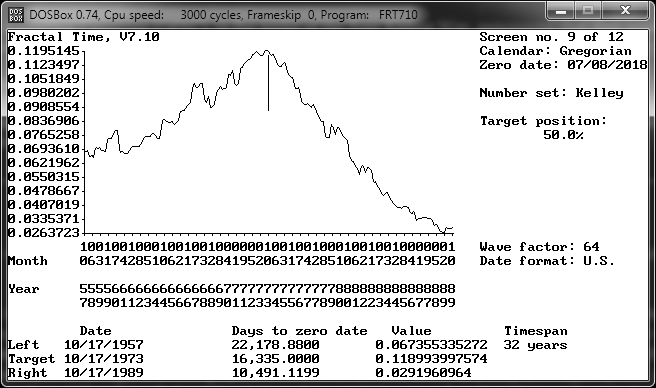
So with this revised zero date, what does the timewave say about the future? Here is how it looks for the six years preceding 2018-07-08:
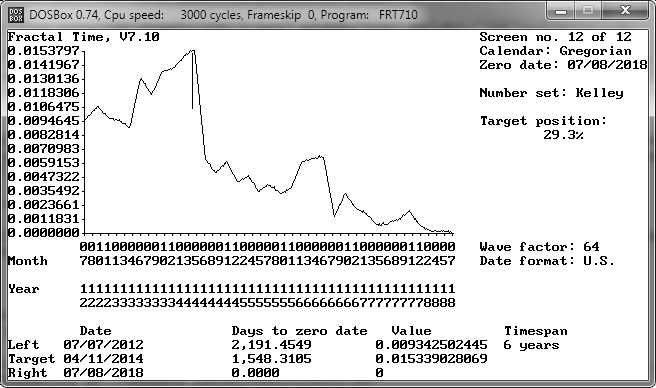
By early April 2014 the Pentagon may feel satisfied that its military build-up (including its Eurasian missile launch sites, stealth missiles, space-based weaponry, weather modification techniques, biowarfare and cyberwarfare capabilities, etc.) is sufficiently complete to launch Operation The Eagle Strikes with a reasonable expectation of success, though in the meantime Russia, China, North Korea and Iran will have made their preparations also.
| The Mathematics of Timewave Zero | |
| The Zero Date | Home Page |